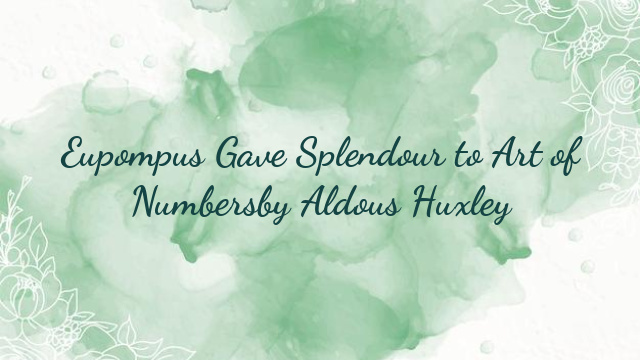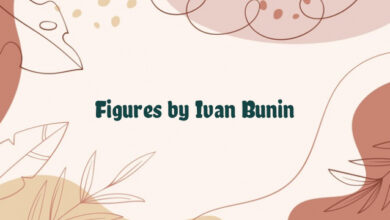
Eupompus Gave Splendour to Art of Numbers
by Aldous Huxley
Eupompus Gave Splendour to Art of Numbers was published in Huxley’s collection titled Limbo, published in 1920. “In his company you would find yourself lifted to the sphere of nimble and mercurial conceptions; you would suddenly realize that some miracle had occurred, that you were living no longer in a dull world of jumbled things but somewhere above the hotch-potch in a glassily perfect universe of ideas.”

“I HAVE made a discovery,” said Emberlin as I entered his room.
“What about?” I asked.
“A discovery,” he replied, “about Discoveries.” He radiated an unconcealed satisfaction; the conversation had evidently gone exactly as he had intended it to go. He had made his phrase, and, repeating it lovingly—“A discovery about Discoveries”—he smiled benignly at me, enjoying my look of mystification—an expression which, I confess, I had purposely exaggerated in order to give him pleasure. For Emberlin, in many ways so childish, took an especial delight in puzzling and nonplussing his acquaintances; and these small triumphs, these little “scores” off people afforded him some of his keenest pleasures. I always indulged his weakness when I could, for it was worth while being on Emberlin’s good books. To be allowed to listen to his post-prandial conversation was a privilege indeed. Not only was he himself a consummately good talker, but he had also the power of stimulating others to talk well. He was like some subtle wine, intoxicating just to the Meredithian level of tipsiness. In his company you would find yourself lifted to the sphere of nimble and mercurial conceptions; you would suddenly realize that some miracle had occurred, that you were living no longer in a dull world of jumbled things but somewhere above the hotch-potch in a glassily perfect universe of ideas, where all was informed, consistent, symmetrical. And it was Emberlin who, godlike, had the power of creating this new and real world. He built it out of words, this crystal Eden, where no belly-going snake, devourer of quotidian dirt, might ever enter and disturb its harmonies. Since I first knew Emberlin I have come to have a greatly enhanced respect for magic and all the formules of its liturgy. If by words Emberlin can create a new world for me, can make my spirit slough off completely the domination of the old, why should not he or I or anyone, having found the suitable phrases, exert by means of them an influence more vulgarly miraculous upon the world of mere things? Indeed, when I compare Emberlin and the common or garden black magician of commerce, it seems to me that Emberlin is the greater thaumaturge. But let that pass; I am straying from my purpose, which was to give some description of the man who so confidentially whispered to me that he had made a discovery about Discoveries.
In the best sense of the word, then, Emberlin was academic. For us who knew him his rooms were an oasis of aloofness planted secretly in the heart of the desert of London. He exhaled an atmosphere that combined the fantastic speculativeness of the undergraduate with the more mellowed oddity of incredibly wise and antique dons. He was immensely erudite, but in a wholly unencyclopædic way—a mine of irrelevant information, as his enemies said of him. He wrote a certain amount, but, like Mallarmé, avoided publication, deeming it akin to “the offence of exhibitionism.” Once, however, in the folly of youth, some dozen years ago, he had published a volume of verses. He spent a good deal of time now in assiduously collecting copies of his book and burning them. There can be but very few left in the world now. My friend Cope had the fortune to pick one up the other day—a little blue book, which he showed me very secretly. I am at a loss to understand why Emberlin wishes to stamp out all trace of it. There is nothing to be ashamed of in the book; some of the verses, indeed, are, in their young ecstatic fashion, good. But they are certainly conceived in a style that is unlike that of his present poems. Perhaps it is that which makes him so implacable against them. What he writes now for very private manuscript circulation is curious stuff. I confess I prefer the earlier work; I do not like the stony, hard-edged quality of this sort of thing—the only one I can remember of his later productions. It is a sonnet on a porcelain figure of a woman, dug up at Cnossus:
“Her eyes of bright unwinking glaze All imperturbable do not Even make pretences to regard The jutting absence of her stays Where many a Syrian gallipot Excites desire with spilth of nard. The bistred rims above the fard Of cheeks as red as bergamot Attest that no shamefaced delays Will clog fulfilment nor retard Full payment of the Cyprian’s praise Down to the last remorseful jot. Hail priestess of we know not what Strange cult of Mycenean days!”
Regrettably, I cannot remember any of Emberlin’s French poems. His peculiar muse expresses herself better, I think, in that language than in her native tongue.
Such is Emberlin; such, I should rather say, was he, for, as I propose to show, he is not now the man that he was when he whispered so confidentially to me, as I entered the room, that he had made a discovery about Discoveries.
I waited patiently till he had finished his little game of mystification and, when the moment seemed ripe, I asked him to explain himself. Emberlin was ready to open out.
“Well,” he began, “these are the facts—a tedious introduction, I fear, but necessary. Years ago, when I was first reading Ben Jonson’s Discoveries, that queer jotting of his, ‘Eupompus gave splendour to Art by Numbers,’ tickled my curiosity. You yourself must have been struck by the phrase, everybody must have noticed it; and everybody must have noticed too that no commentator has a word to say on the subject. That is the way of commentators—the obvious points fulsomely explained and discussed, the hard passages, about which one might want to know something passed over in the silence of sheer ignorance. ‘Eupompus gave splendour to Art by Numbers’—the absurd phrase stuck in my head. At one time it positively haunted me. I used to chant it in my bath, set to music as an anthem. It went like this, so far as I remember”—and he burst into song: “‘Eupompus, Eu-u-pompus gave sple-e-e-endour . . .’” and so on, through all the repetitions, the dragged-out rises and falls of a parodied anthem.
“I sing you this,” he said when he had finished, “just to show you what a hold that dreadful sentence took upon my mind. For eight years, off and on, its senselessness has besieged me. I have looked up Eupompus in all the obvious books of reference, of course. He is there all right—Alexandrian artist, eternized by some wretched little author in some even wretcheder little anecdote, which at the moment I entirely forget; it had nothing, at any rate, to do with the embellishment of art by numbers. Long ago I gave up the search as hopeless; Eupompus remained for me a shadowy figure of mystery, author of some nameless outrage, bestower of some forgotten benefit upon the art that he practised. His history seemed wrapt in an impenetrable darkness. And then yesterday I discovered all about him and his art and his numbers. A chance discovery, than which few things have given me a greater pleasure.
“I happened upon it, as I say, yesterday when I was glancing through a volume of Zuylerius. Not, of course, the Zuylerius one knows,” he added quickly, “otherwise one would have had the heart out of Eupompus’ secret years ago.”
“Of course,” I repeated, “not the familiar Zuylerius.”
“Exactly,” said Emberlin, taking seriously my flippancy, “not the familiar John Zuylerius, Junior, but the elder Henricus Zuylerius, a much less—though perhaps undeservedly so—renowned figure than his son. But this is not the time to discuss their respective merits. At any rate, I discovered in a volume of critical dialogues by the elder Zuylerius, the reference, to which, without doubt, Jonson was referring in his note. (It was of course a mere jotting, never meant to be printed, but which Jonson’s literary executors pitched into the book with all the rest of the available posthumous materials.) ‘Eupompus gave splendour to Art by Numbers’—Zuylerius gives a very circumstantial account of the process. He must, I suppose, have found the sources for it in some writer now lost to us.”
Emberlin paused a moment to muse. The loss of the work of any ancient writer gave him the keenest sorrow. I rather believe he had written a version of the unrecovered books of Petronius. Some day I hope I shall be permitted to see what conception Emberlin has of the Satyricon as a whole. He would, I am sure, do Petronius justice—almost too much, perhaps.
“What was the story of Eupompus?” I asked. “I am all curiosity to know.”
Emberlin heaved a sigh and went on.
“Zuylerius’ narrative,” he said, “is very bald, but on the whole lucid; and I think it gives one the main points of the story. I will give it you in my own words; that is preferable to reading his Dutch Latin. Eupompus, then, was one of the most fashionable portrait-painters of Alexandria. His clientele was large, his business immensely profitable. For a half-length in oils the great courtesans would pay him a month’s earnings. He would paint likenesses of the merchant princes in exchange for the costliest of their outlandish treasures. Coal-black potentates would come a thousand miles out of Ethiopia to have a miniature limned on some specially choice panel of ivory; and for payment there would be camel-loads of gold and spices. Fame, riches, and honour came to him while he was yet young; an unparalleled career seemed to lie before him. And then, quite suddenly, he gave it all up—refused to paint another portrait. The doors of his studio were closed. It was in vain that clients, however rich, however distinguished, demanded admission; the slaves had their order; Eupompus would see no one but his own intimates.”
Emberlin made a pause in his narrative.
“What was Eupompus doing?” I asked.
“He was, of course,” said Emberlin, “occupied in giving splendour to Art by Numbers. And this, as far as I can gather from Zuylerius, is how it all happened. He just suddenly fell in love with numbers—head over ears, amorous of pure counting. Number seemed to him to be the sole reality, the only thing about which the mind of man could be certain. To count was the one thing worth doing, because it was the one thing you could be sure of doing right. Thus, art, that it may have any value at all, must ally itself with reality—must, that is, possess a numerical foundation. He carried the idea into practice by painting the first picture in his new style. It was a gigantic canvas, covering several hundred square feet—I have no doubt that Eupompus could have told you the exact area to an inch—and upon it was represented an illimitable ocean covered, as far as the eye could reach in every direction, with a multitude of black swans. There were thirty-three thousand of these black swans, each, even though it might be but a speck on the horizon, distinctly limned. In the middle of the ocean was an island, upon which stood a more or less human figure having three eyes, three arms and legs, three breasts and three navels. In the leaden sky three suns were dimly expiring. There was nothing more in the picture; Zuylerius describes it exactly. Eupompus spent nine months of hard work in painting it. The privileged few who were allowed to see it pronounced it, finished, a masterpiece. They gathered round Eupompus in a little school, calling themselves the Philarithmics. They would sit for hours in front of his great work, contemplating the swans and counting them; according to the Philarithmics, to count and to contemplate were the same thing.
“Eupompus’ next picture, representing an orchard of identical trees set in quincunxes, was regarded with less favour by the connoisseurs. His studies of crowds were, however, more highly esteemed; in these were portrayed masses of people arranged in groups that exactly imitated the number and position of the stars making up various of the more famous constellations. And then there was his famous picture of the amphitheatre, which created a furore among the Philarithmics. Zuylerius again gives us a detailed description. Tier upon tier of seats are seen, all occupied by strange Cyclopean figures. Each tier accommodates more people than the tier below, and the number rises in a complicated but regular progression. All the figures seated in the amphitheatre possess but a single eye, enormous and luminous, planted in the middle of the forehead: and all these thousands of single eyes are fixed, in a terrible and menacing scrutiny, upon a dwarf-like creature cowering pitiably in the arena. . . . He alone of the multitude possesses two eyes.
“I would give anything to see that picture,” Emberlin added, after a pause. “The colouring, you know; Zuylerius gives no hint, but I feel somehow certain that the dominant tone must have been a fierce brick-red—a red granite amphitheatre filled with a red-robed assembly, sharply defined against an implacable blue sky.”
“Their eyes would be green,” I suggested.
Emberlin closed his eyes to visualize the scene and then nodded a slow and rather dubious assent.
“Up to this point,” Emberlin resumed at length, “Zuylerius’ account is very clear. But his descriptions of the later philarithmic art become extremely obscure; I doubt whether he understood in the least what it was all about. I will give you such meaning as I manage to extract from his chaos. Eupompus seems to have grown tired of painting merely numbers of objects. He wanted now to represent Number itself. And then he conceived the plan of rendering visible the fundamental ideas of life through the medium of those purely numerical terms into which, according to him, they must ultimately resolve themselves. Zuylerius speaks vaguely of a picture of Eros, which seems to have consisted of a series of interlacing planes. Eupompus’ fancy seems next to have been taken by various of the Socratic dialogues upon the nature of general ideas, and he made a series of illustrations for them in the same arithmo-geometric style. Finally there is Zuylerius’ wild description of the last picture that Eupompus ever painted. I can make very little of it. The subject of the work, at least, is clearly stated; it was a representation of Pure Number, or God and the Universe, or whatever you like to call that pleasingly inane conception of totality. It was a picture of the cosmos seen, I take it, through a rather Neoplatonic camera obscura—very clear and in small. Zuylerius suggests a design of planes radiating out from a single point of light. I dare say something of the kind came in. Actually, I have no doubt, the work was a very adequate rendering in visible form of the conception of the one and the many, with all the intermediate stages of enlightenment between matter and the Fons Deitatis. However, it’s no use speculating what the picture may have been going to look like. Poor old Eupompus went mad before he had completely finished it and, after he had dispatched two of the admiring Philarithmics with a hammer, he flung himself out of the window and broke his neck. That was the end of him, and that was how he gave splendour, regrettably transient, to Art by Numbers.”
Emberlin stopped. We brooded over our pipes in silence; poor old Eupompus!
That was four months ago, and to-day Emberlin is a confirmed and apparently irreclaimable Philarithmic, a quite whole-hearted Eupompian.
It was always Emberlin’s way to take up the ideas that he finds in books and to put them into practice. He was once, for example, a working alchemist, and attained to considerable proficiency in the Great Art. He studied mnemonics under Bruno and Raymond Lully, and constructed for himself a model of the latter’s syllogizing machine, in hopes of gaining that universal knowledge which the Enlightened Doctor guaranteed to its user. This time it is Eupompianism, and the thing has taken hold of him. I have held up to him all the hideous warnings that I can find in history. But it is no use.
There is the pitiable spectacle of Dr. Johnson under the tyranny of an Eupompian ritual, counting the posts and the paving-stones of Fleet Street. He himself knew best how nearly a madman he was.
And then I count as Eupompians all gamblers, all calculating boys, all interpreters of the prophecies of Daniel and the Apocalypse; then too the Elberfeld horses, most complete of all Eupompians.
And here was Emberlin joining himself to this sect, degrading himself to the level of counting beasts and irrational children and men, more or less insane. Dr. Johnson was at least born with a strain of the Eupompian aberration in him; Emberlin is busily and consciously acquiring it. My expostulations, the expostulations of all his friends, are as yet unavailing. It is in vain that I tell Emberlin that counting is the easiest thing in the world to do, that when I am utterly exhausted, my brain, for lack of ability to perform any other work, just counts and reckons, like a machine, like an Elberfeld horse. It all falls on deaf ears; Emberlin merely smiles and shows me some new numerical joke that he has discovered. Emberlin can never enter a tiled bathroom now without counting how many courses of tiles there are from floor to ceiling. He regards it as an interesting fact that there are twenty-six rows of tiles in his bathroom and thirty-two in mine, while all the public lavatories in Holborn have the same number. He knows now how many paces it is from any one point in London to any other. I have given up going for walks with him. I am always made so distressingly conscious by his preoccupied look, that he is counting his steps.
His evenings, too, have become profoundly melancholy; the conversation, however well it may begin, always comes round to the same nauseating subject. We can never escape numbers; Eupompus haunts us. It is not as if we were mathematicians and could discuss problems of any interest or value. No, none of us are mathematicians, least of all Emberlin. Emberlin likes talking about such points as the numerical significance of the Trinity, the immense importance of its being three in one, not forgetting the even greater importance of its being one in three. He likes giving us statistics about the speed of light or the rate of growth in fingernails. He loves to speculate on the nature of odd and even numbers. And he seems to be unconscious how much he has changed for the worse. He is happy in an exclusively absorbing interest. It is as though some mental leprosy had fallen upon his intelligence.
In another year or so, I tell Emberlin, he may almost be able to compete with the calculating horses on their own ground. He will have lost all traces of his reason, but he will be able to extract cube roots in his head. It occurs to me that the reason why Eupompus killed himself was not that he was mad; on the contrary, it was because he was, temporarily, sane. He had been mad for years, and then suddenly the idiot’s self-complacency was lit up by a flash of sanity. By its momentary light he saw into what gulfs of imbecility he had plunged. He saw and understood, and the full horror, the lamentable absurdity of the situation made him desperate. He vindicated Eupompus against Eupompianism, humanity against the Philarithmics. It gives me the greatest pleasure to think that he disposed of two of that hideous crew before he died himself.




